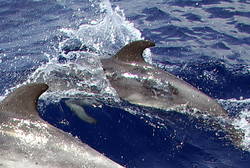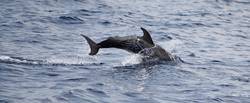Unresolved skin anomaly in a bottlenose dolphin
 As a follow up to a posting to MARMAM on the skin anomaly observed in a bottlenose dolphin off La Gomera (see below) we summarize the feedback by many researchers. Thanks to everyone who provided advice and suggestions. We appreciate that it is very difficult to diagnose on the basis of a photographic image. Persistent remora damage was suggested by several researchers. In Hawaii, researchers observed an individual young Tursiops with a skin “rash” that looked like the one in our photo. Each time the animal was seen, it was with an attached remora. In some remora species at least, the dorsal sucker disk contains several rows of modified spines that actually protrude beyond the flesh of the disk, and therefore will penetrate the skin of the host animal. In the case of the dolphins, this could cause abrasions of the skin, leading to the apparent rash.
As a follow up to a posting to MARMAM on the skin anomaly observed in a bottlenose dolphin off La Gomera (see below) we summarize the feedback by many researchers. Thanks to everyone who provided advice and suggestions. We appreciate that it is very difficult to diagnose on the basis of a photographic image. Persistent remora damage was suggested by several researchers. In Hawaii, researchers observed an individual young Tursiops with a skin “rash” that looked like the one in our photo. Each time the animal was seen, it was with an attached remora. In some remora species at least, the dorsal sucker disk contains several rows of modified spines that actually protrude beyond the flesh of the disk, and therefore will penetrate the skin of the host animal. In the case of the dolphins, this could cause abrasions of the skin, leading to the apparent rash.
Others suggested the lesion could be caused by Blastomyces spp., a kind of fungi that is found on stressed (and thus immunodepressed) animals. Another fungal disease which is contagious to humans is “Lobomycosis”, it shows very similar skin irregularities as seen from the pictures.
Some colleagues also speculated about bacterial infections (e.g. marine vibrios).
Still others thought it looks like a trauma-induced condition, i.e. some type of trauma may have abraded the skin and then an infection, possibly fungal, may have set in. Again, there would be a relation to reduced immune function.
Hence, vibrio bacteria, Papillomavirus, Herpesvirus, Morbillivirus and Poxviruses, or a fungus as well as Parasites could all cause these lesions. We have to stress that there were divergent valuations about almost all of these potential causes.
As a synthesis, we suggest the following to be the most likely scenario:
After the remora can be clearly seen on the image, and given its location, the skin of the dolphin may have suffered from its attachment. We have seen many emaciated dolphins this year and therefore some individuals probably are stressed by missing feeding opportunities, i.e. they were prone to immunodepression. In this situation, a damage of the skin (e.g. by the remora or other causes) has triggered a secondary infection – either viral, fungal or bacterial or through parasites – but a definite identification of the eliciting agent is not possible via photographic images only.
Unresolved skin anomaly in a bottlenose dolphin

Bottlenose dolphin with skin anomaly. Please note that a remora is attached to the dolphin, too. (C) M. Lüthi-Toledo
Berlin/La Gomera, November 2011. During autumn 2012 we observed a number of bottlenose dolphins obvious with skin anomalies / skin diseases off La Gomera (Canary Islands). While emaciated bottlenose dolphins have become a more or less regular sight during the past, and some anomalies can be explained relatively straight away, at least one case from October 2012 is still puzzling.
This bottlenose dolphin calf carried large patches on both flanks, where its skin looked atypical in colour and character, hence appeared as a skin disease. This anomaly didn’t look like anything we had observed so far. We were able to shoot some good quality photographic images of the individual, which are represented here (click on the images to enlarge).
Vet advice requested

Bottlenose dolphin with skin anomaly. Please note that a remora is attached to the dolphin, too. (C) M. Lüthi-Toledo
If you have veterinary and/or pathological experience with cetaceans, we would like to know if you know about the (potential) cause for this anomaly. We will be grateful for any suggestions, which finally will be used for our study “Anomalies in Cetaceans off La Gomera” launched in 2010. If you want to receive high resolution images, please send a request to info@m-e-e-r.de .
Since many years we are documenting all kinds of abberrancies in different cetacean species off La Gomera. This can be injuries / wounds as well as individuals which appear weakended / ill or carrying apparent skin diseases. We encourage whale watchers to take photographs of animals which they consider abnormal. At times, you can thus contribute to our scientific study as a tourist.